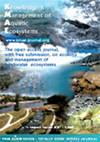半月原虾虎鱼(Proterorhinus semiilunaris)和新虾虎鱼(Neogobius fluviatilis)两种本地虾虎鱼栖息地使用的可塑性:对入侵种群的影响
IF 1.7
3区 环境科学与生态学
Q3 FISHERIES
引用次数: 4
摘要
本—里海地区是一些入侵的虾虎鱼的重要来源地。这些鱼已经在欧洲和北美的几个淡水生态系统中定居。由于对其栖息地利用的认识仍然有限,本研究在土耳其西北部马尔马拉地区的4个天然湖泊中,对西管糖虾虎鱼、半月原虾虎鱼和猴虾虎鱼的季节性栖息地利用进行了研究。两种树种的生境利用在湖泊和季节之间变化很大,其中半月树表现出较高的可塑性。一般来说,半月树的主要栖息地是有植被覆盖的沿海地区的浅水,而河流蕨则一直在缺乏植被的较深水域使用沙质基质。这些结果表明,这两种虾虎鱼的栖息地利用具有高度的可塑性,尤其是半月形虾虎鱼,这可能有助于它们建立和入侵新环境的能力。对半月树的入侵尤其脆弱的生境是中等大小的基质,为个体提供了足够的避难空间。提供不同栖息地的水域,如沙质基质,可能会抑制它们的定植,但可能更容易受到河流奈丝虫的入侵。本文章由计算机程序翻译,如有差异,请以英文原文为准。
Plasticity in habitat use of two native Ponto-Caspian gobies, Proterorhinus semilunaris and Neogobius fluviatilis: implications for invasive populations
The Ponto-Caspian region is an important source area for some invasive gobiid fishes. These fishes have colonised several freshwater ecosystems in Europe, as well as in North America. As knowledge on their habitat utilisation in their native range remains limited, the seasonal habitat uses of Western tubenose goby, Proterorhinus semilunaris and monkey goby Neogobius fluviatilis were studied in four natural lakes in the Marmara Region (NW Turkey). Habitat use of both species was highly variable between the lakes and seasons, with P. semilunaris showing higher plasticity. In general, the main habitats used by P. semilunaris were shallow waters in littoral areas that had vegetation cover, whereas N. fluviatilis consistently used sandy substratum in deeper waters that lacked vegetation. These results suggested there was high plasticity in the habitat utilisation of these two gobiids, especially in P. semilunaris, which potentially facilitates their ability to establish and invade novel environments. The habitats that are especially vulnerable to P. semilunaris invasion are medium size substrates which provide individuals with sufficient interstitial space for refuge. Waters providing differing habitats, such as sandy substrata, might inhibit their colonisation, but are potentially more vulnerable to N. fluviatilis invasion.
求助全文
通过发布文献求助,成功后即可免费获取论文全文。
去求助
来源期刊

Knowledge and Management of Aquatic Ecosystems
环境科学-海洋与淡水生物学
CiteScore
3.70
自引率
5.60%
发文量
22
审稿时长
>12 weeks
期刊介绍:
Knowledge and Management of Aquatic Ecosystems (KMAE-Bulletin Français de la Pêche et de la Pisciculture since 1928) serves as a foundation for scientific advice across the broad spectrum of management and conservation issues related to freshwater ecosystems.
The journal publishes articles, short communications, reviews, comments and replies that contribute to a scientific understanding of freshwater ecosystems and the impact of human activities upon these systems. Its scope includes economic, social, and public administration studies, in so far as they are directly concerned with the management of freshwater ecosystems (e.g. European Water Framework Directive, USA Clean Water Act, Canadian Water Quality Guidelines, …) and prove of general interest to freshwater specialists. Papers on insular freshwater ecosystems and on transitional waters are welcome. KMAE is not a preferred journal for taxonomical, physiological, biological, toxicological studies, unless a clear link to ecological aspects can be established. Articles with a very descriptive content can be accepted if they are part of a broader ecological context.
 求助内容:
求助内容: 应助结果提醒方式:
应助结果提醒方式:


